Abromination
Hazard to Others
  
Posts: 432
Registered: 10-7-2018
Location: Alaska
Member Is Offline
Mood: 1,4 tar
|
|
Proper Chemical Labeling
I have been wondering for a while what the average amateur standards are for labelin chemicals. For a lot of them, I just write the name on the bottle
and put them up. For some other chemicals I am wondering if I am going to far. For example, some of my more benign chemicals (sodium carbonate,
calcium sulfate, etc.) just have the name and sometimes the formula hand written on the bottle. For others, like hydrochloric acid and ammonium
hydroxide I print out much more elaborate labels including the concentration, chemical formula, processes by which it was made, UN pictograms and all
cautions. Is it really that necessary or a good idea or am I wasting my time?
Ill include some pictures of my lables.
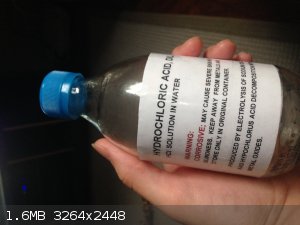 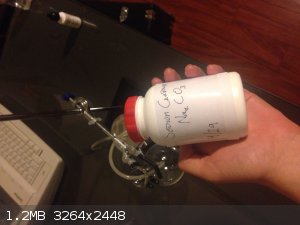 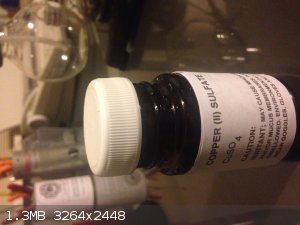 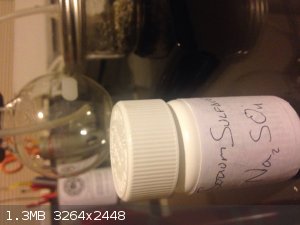
List of materials made by ScienceMadness.org users:
https://docs.google.com/spreadsheets/d/1nmJ8uq-h4IkXPxD5svnT...
--------------------------------
Elements Collected: H, Li, B, C, N, O, Mg, Al, Si, P, S, Fe, Ni, Cu, Zn, Ag, I, Au, Pb, Bi, Am
Last Acquired: B
Next: Na
-------------- |
|
|
Hendrik
Harmless

Posts: 23
Registered: 29-7-2018
Member Is Offline
|
|
When working in a proper lab (not a home one), providing all information is necessary. When labeling them in a home lab, I don't think mentioning
something else than the name, chemical formula and concentration is necessary. Health information should be provided only when the compound is highly
toxic/carcinogenic/radioactive.
|
|
|
Abromination
Hazard to Others
  
Posts: 432
Registered: 10-7-2018
Location: Alaska
Member Is Offline
Mood: 1,4 tar
|
|
Quote: Originally posted by Hendrik  | | When working in a proper lab (not a home one), providing all information is necessary. When labeling them in a home lab, I don't think mentioning
something else than the name, chemical formula and concentration is necessary. Health information should be provided only when the compound is highly
toxic/carcinogenic/radioactive. |
Thats what I thought. Although I would highly doubt for this to happen, but should I be keeping MSDSs incase I somehow managed to poison myself? I
don't see it happening but everyone makes mistakes.
List of materials made by ScienceMadness.org users:
https://docs.google.com/spreadsheets/d/1nmJ8uq-h4IkXPxD5svnT...
--------------------------------
Elements Collected: H, Li, B, C, N, O, Mg, Al, Si, P, S, Fe, Ni, Cu, Zn, Ag, I, Au, Pb, Bi, Am
Last Acquired: B
Next: Na
-------------- |
|
|
Hendrik
Harmless

Posts: 23
Registered: 29-7-2018
Member Is Offline
|
|
Keep a table (I use google sheets) with all your chemicals, their quantities, their sources, health information (NFPA), chemical formulas and names,
CAS and EINECS numbers and MSDSs (sciencelab provides a lot of information regarding the toxicological and chemical properties of a lot of compounds).
Add the links to the MSDSs in the table.
|
|
|
Sulaiman
International Hazard
    
Posts: 3555
Registered: 8-2-2015
Location: 3rd rock from the sun
Member Is Offline
|
|
Who are the labels for ?
. for my own use I only need the chemical name, concentration and/or purity, with a note 'synthesised' if I made it myself.
and sometimes the tare weight of the container.
. for the benefit of others (who should not be in my lab without me present) I add in red, warnings such as
TOXIC, FLAMMABLE, CORROSIVE, CAUSTIC, OXIDISER etc.
I do not believe that overly detailed labelling helps anyone,
. firemen would not enter my lab/shed to read the labels if it were on fire
. hazmat or law enforcement operatives should only need the basic labelling information
I use hand-written cheap self-adhesive paper labels,
for solvents I like to mark (on the label or bottle) the current level so that if there is excessive evaporation/leakage/loss it can be spotted.
The main thing that I am changing with my labelling is that I shall be adding the date of purchase or synthesis to new labels,
mainly to make it easy to look up the chemical in my lab notes.
|
|
|
JJay
International Hazard
    
Posts: 3440
Registered: 15-10-2015
Member Is Offline
|
|
This is the standard used by law in professional labs in the U.S.: https://www.osha.gov/dsg/hazcom/
Amateur labs are not required to follow OSHA regulations, but it doesn't hurt.
TBH, I typically just label newly made chemicals with the name of the chemical and its grade unless someone else might be handling it, in which case
I'll use GHS labels, sometimes with NFPA icons. I usually just keep chemicals in the containers that they came in, and when I have to transfer them to
new containers for storage, I typically transfer the labels with them.
The only real function of GHS labels, IMHO, is increasing the unemployment rate for attorneys. If someone needs a warning label saying that sulfuric
acid is corrosive, he/she shouldn't be in the lab. That said, I should possibly reconsider my approach out of respect for cleaning personnel in case I
am struck by lightning or something, but really, I am more worried about the hazards inherent in an unlabeled 5-gallon can of gasoline than everything
in my lab combined.
Chemicals synthesized in labs for internal use don't have to comply with GHS requirements [see 29 CFR 1910.1450(h)(2)(iii) for more information].
Note: I just realized that the label on my bottle of sulfur is out of compliance. The rest of my labels comply with OSHA requirements, even though
that's not really necessary. I suppose I will put a proper label on my bottle of sulfur....
[Edited on 22-8-2018 by JJay]
|
|
|
Abromination
Hazard to Others
  
Posts: 432
Registered: 10-7-2018
Location: Alaska
Member Is Offline
Mood: 1,4 tar
|
|
Now I know that I am going to get a lot of crap for this, but my lab is in my bedroom. I don't actually do anything dangerous in there and I have a
glass lab table and a hood mostly for smelly stuff. The most dangerous thing ever to give of fumes in it was ammonium hydroxide. I do most everything
else outside.
Anyways I do regulary have people in there although all of them are at least 15. Unless my mom was in there or sister for some reason I am always
them in there.
Probably not an issue, but would that make you reconsider at all?
Also, close enough 
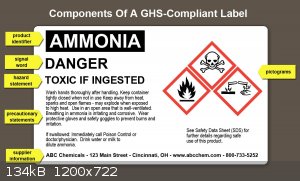
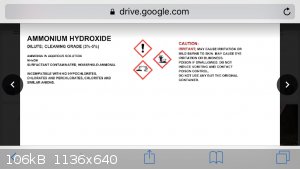
[Edited on 23-8-18 by Abromination]
List of materials made by ScienceMadness.org users:
https://docs.google.com/spreadsheets/d/1nmJ8uq-h4IkXPxD5svnT...
--------------------------------
Elements Collected: H, Li, B, C, N, O, Mg, Al, Si, P, S, Fe, Ni, Cu, Zn, Ag, I, Au, Pb, Bi, Am
Last Acquired: B
Next: Na
-------------- |
|
|
Sidmadra
Hazard to Others
  
Posts: 129
Registered: 17-2-2017
Member Is Offline
Mood: No Mood
|
|
Depends who is accessing your lab really. I just put the names of the chemicals, if necessary the concentration, and sometimes whether I synthesized
it. I've got a really good memory and am able to remember the details, appearance, odor, particle size, fluffiness, and density of pretty much all
120+ chemicals in my lab. Not in the sense that I can recall it all off the top of my head, but I can immediately recognize them. Combine that with
having collected a large number of chemical containers over the years, I have a wide enough variety where similar looking containers aren't a problem.
In my opinion, the times when labels are really useful is when law enforcement are in your lab. It's my opinion that if any amateur chemist is
practicing long enough, they will attract the attention of law enforcement in some manner of speaking, whether by accident, innocent ebay chemical
purchase, and so on. It's my experience that when your chemicals are labeled, law enforcement doesn't even bother to open them most of the time. I've
had law enforcement in my lab on more than one occasion for different unintended reasons. In both cases they didn't open or check the majority of the
labeled containers in my lab. The only ones they did open and test were crystalline compounds that I had forgotten to label. It goes without saying
everything I do in my lab is legal and transparent, so I wasn't worried much in the first place. I'm sure they realized it wasn't a drug lab due to
the sheer variety of chemicals I had, none of which were illicit. Police are naturally skeptical of anything chemistry related.
[Edited on 23-8-2018 by Sidmadra]
|
|
|
|